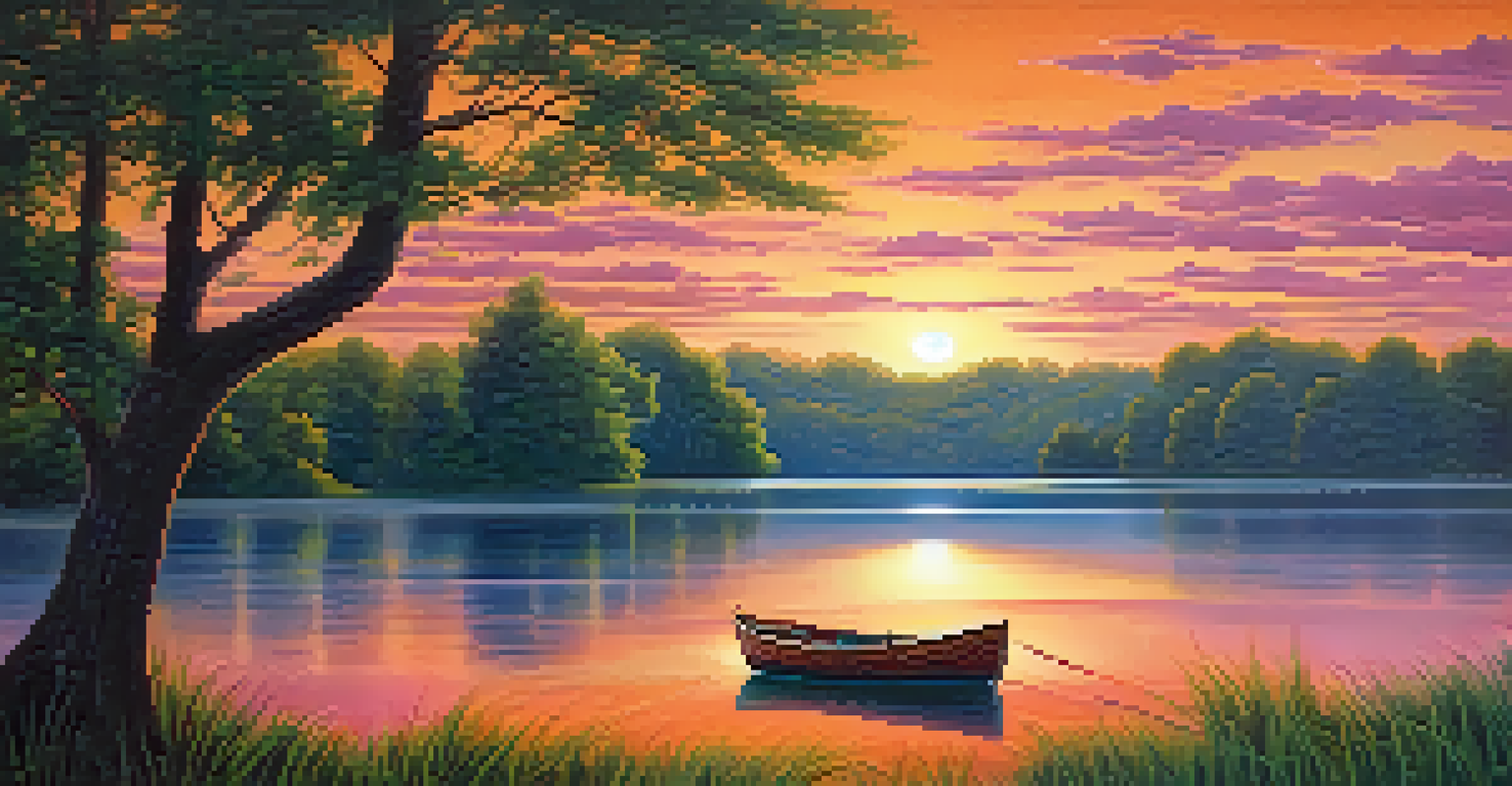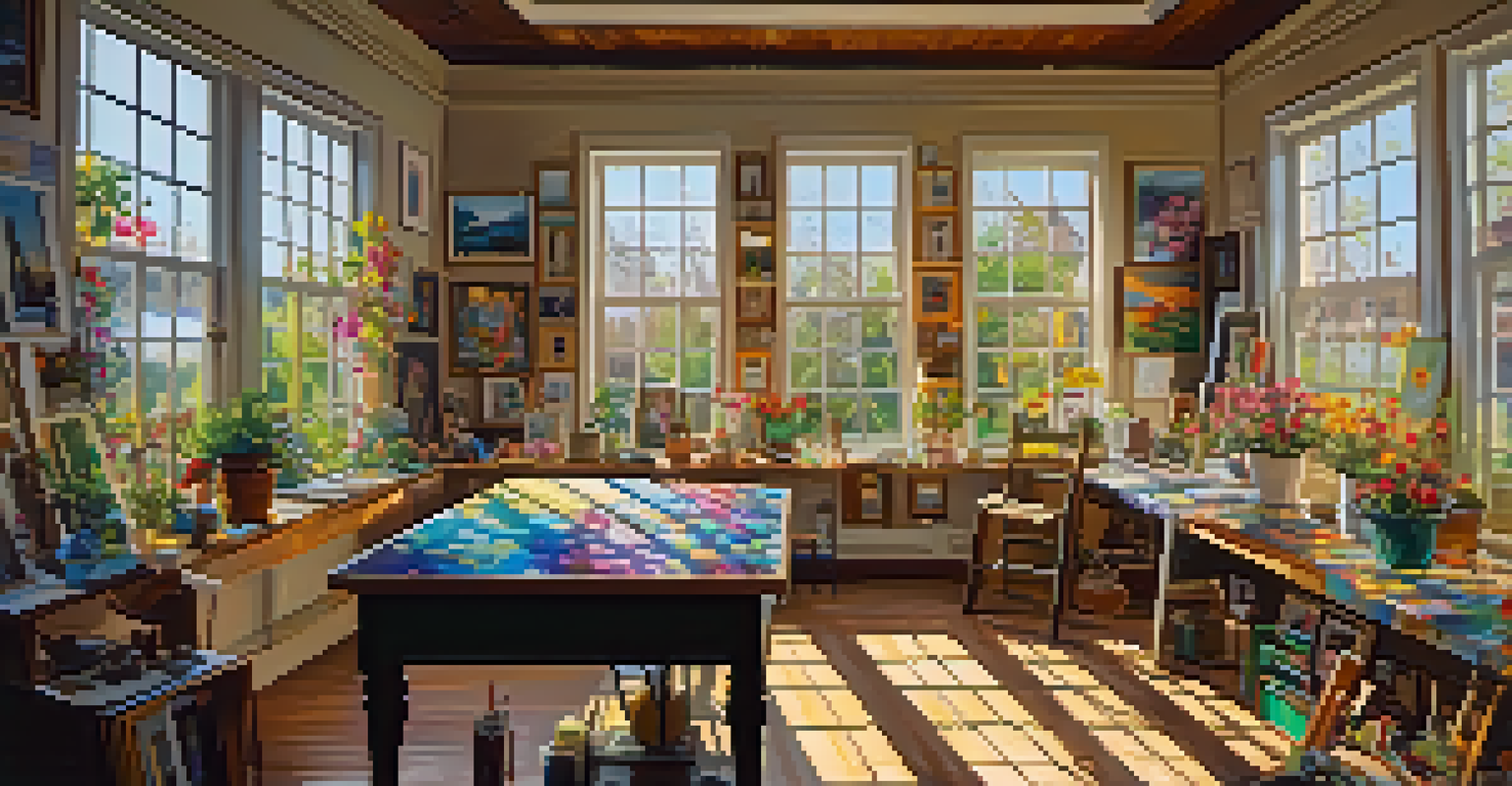Artistic Journeys: The Intersection of Art and Literature

The Synergy Between Visual Art and Literature
Art and literature have long danced together, each influencing the other in profound ways. Think of a beautiful painting that evokes emotions, much like a powerful poem does. When an artist captures a moment on canvas, they often tell a story that resonates with literary themes, creating a dialogue between the two mediums.
Art is the most beautiful of all lies.
Consider Vincent van Gogh's 'Starry Night.' This iconic piece not only showcases stunning visuals but also invites viewers to ponder deeper themes of isolation and hope. Similarly, literature can paint vivid imagery with words, allowing readers to visualize scenes as if they were artworks themselves. This interplay enriches both forms of expression.
Ultimately, the synergy between visual art and literature fosters a deeper appreciation for both. Artists and writers draw inspiration from each other, creating works that are layered with meaning and emotion, inviting audiences to explore the complexities of human experience.
Literary Inspirations Behind Iconic Artworks
Many renowned artists have found their muse in literature, transforming words into visual narratives. For instance, Salvador Dalí's paintings often reflect his fascination with surrealist literature, making the viewer feel as though they’ve stepped into a dream. This connection illustrates how literature can ignite an artist's imagination, leading to groundbreaking works.

Take, for example, the collaboration between illustrator Arthur Rackham and various authors. Rackham’s enchanting illustrations in 'Peter Pan' or 'Alice in Wonderland' bring to life the whimsical worlds crafted by J.M. Barrie and Lewis Carroll. His art enhances the storytelling, creating a richer experience for the audience.
Art and Literature Inspire Each Other
The interplay between visual art and literature creates a rich dialogue that enhances the understanding and appreciation of both forms.
These examples show that literature doesn't just inspire individual pieces; it can shape entire movements in the art world. By weaving literary elements into their work, artists create a multifaceted experience that invites viewers to engage with both the text and the visual representation.
The Role of Narrative in Visual Arts
Narrative plays a crucial role in both literature and visual arts, allowing creators to tell stories that resonate deeply. In a painting, the arrangement of figures and objects can convey a storyline, much like a well-crafted plot in a novel. This narrative quality invites viewers to interpret the scene and draw connections to their own experiences.
A picture is worth a thousand words.
For instance, Diego Rivera's murals often depict historical events and social struggles, engaging viewers in a conversation about culture and identity. Each character in his work tells a part of the story, much like characters in a novel develop the plot. This narrative aspect transforms the mural from mere decoration into a historical commentary.
By incorporating narrative elements, artists can guide viewers through their creations, sparking imagination and reflection. This connection between storytelling and visual representation emphasizes the importance of context in understanding both art and literature.
The Impact of Art on Literary Themes
Art can significantly shape literary themes, influencing the way stories are told and received. Authors often draw inspiration from visual elements to enhance their narratives. For example, the use of color and imagery in a novel can evoke emotions that parallel visual artworks, enriching the reader's experience.
Consider how the vibrant imagery in Gabriel García Márquez's 'One Hundred Years of Solitude' mirrors the magical realism often found in contemporary art. The blending of fantastical elements with everyday life creates a tapestry that resonates with both visual artists and writers alike. This cross-pollination of ideas can lead to innovative storytelling techniques.
Narrative Connects Visual and Textual
Narrative elements in visual art allow viewers to engage with stories similarly to how they do with literature, deepening emotional resonance.
Ultimately, the impact of art on literature showcases the fluidity of creative expression. As artists and writers explore new themes and styles, they push the boundaries of their respective mediums, encouraging audiences to engage with both art forms in new and exciting ways.
Artistic Movements: Literature and Visual Art Unite
Throughout history, artistic movements have often blurred the lines between literature and visual art. The Romantic movement, for instance, celebrated emotion and nature in both poetry and painting, with artists like Caspar David Friedrich and poets like William Wordsworth drawing upon similar themes. This collaboration fostered a deeper understanding of the human experience.
The Surrealist movement further exemplifies this connection, as artists and writers sought to explore the subconscious mind. Think of how Salvador Dalí's dreamlike paintings resonate with the surreal narratives of writers like André Breton. Together, they created a cultural landscape that challenged conventional perceptions of reality.
By examining these movements, we see how literature and visual art can coalesce to form a richer cultural tapestry. The resulting synergy not only enhances our appreciation for each form but also encourages us to explore new ideas and perspectives.
The Modern Fusion of Art and Literature
In today's world, the fusion of art and literature is more pronounced than ever. Digital platforms allow for innovative collaborations, where writers can create interactive narratives that incorporate visual elements. This intersection provides new avenues for storytelling, making literature more accessible and engaging for diverse audiences.
Graphic novels and illustrated books exemplify this modern fusion, as they combine the narrative depth of literature with the visual appeal of art. Works like 'Maus' by Art Spiegelman and 'Persepolis' by Marjane Satrapi demonstrate how images can enhance storytelling, providing a powerful commentary on culture and history.
Future Embraces Art-Literature Fusion
Advancements in technology are paving the way for innovative collaborations between art and literature, leading to immersive storytelling experiences.
As we embrace this modern approach, we see the boundaries between art and literature continue to dissolve. This evolution reflects the dynamic nature of creativity, inviting us to explore new forms of expression and understand the world around us in more nuanced ways.
The Future of Art and Literature: A Collaborative Horizon
Looking ahead, the future of art and literature promises exciting possibilities for collaboration. With advancements in technology, creators can explore new mediums that blend text and visuals in innovative ways. This evolution opens up a world of potential, allowing for immersive experiences that engage audiences on multiple levels.
Virtual reality (VR) and augmented reality (AR) are just a few examples of how technology can enhance the relationship between art and literature. Imagine stepping into the pages of a book while surrounded by stunning visuals that bring the story to life, or engaging with an artwork that reveals its narrative through interactive storytelling. These experiences can deepen our understanding and appreciation of both forms.

As artists and writers continue to push the boundaries of their crafts, we can anticipate a future filled with creativity and collaboration. The intersection of art and literature will undoubtedly evolve, inviting audiences to engage with stories and visuals in ways we have yet to imagine.